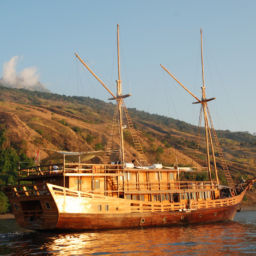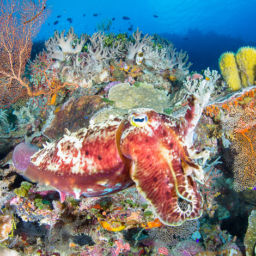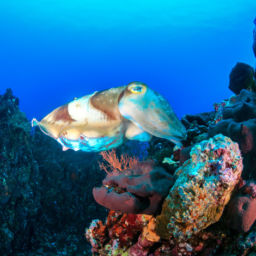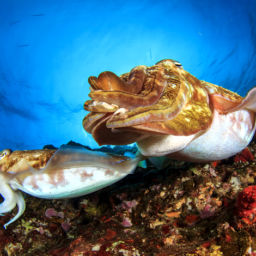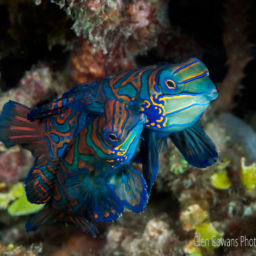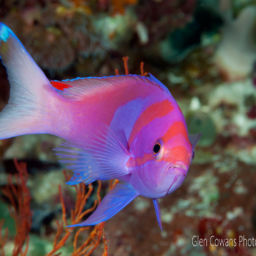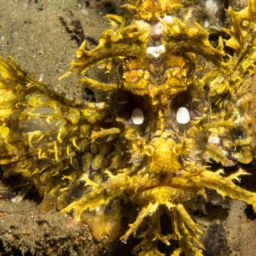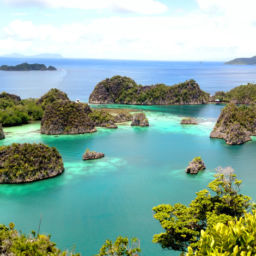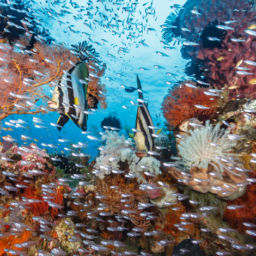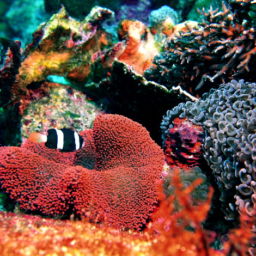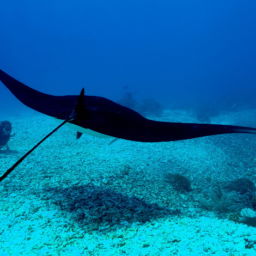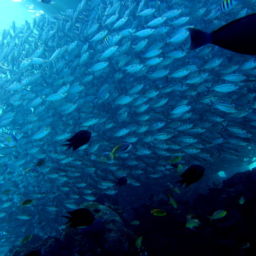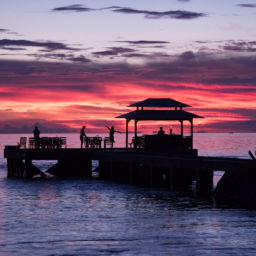Luxurious land-based Wakatobi Dive Resort offers access to over 40 pristine dive sites. Guests can visit even more aboard the equally luxurious Pelagian. This 115-foot (35 m) luxury dive yacht cruises a broader area of the Wakatobi archipelago and the southern portion of Buton Island. These waters lie within the Coral Triangle, home to the highest coral-reef biodiversity in the world. Seven-day itineraries take in a diverse range of underwater environments. The areas from Wangi Wangi to the vast Kaledupa shoals offer everything from shallow reefs to offshore pinnacles and dramatic vertical drop offs. Buton’s Pasar Wajo Bay means exceptional muck diving.
Cruising on the Pelagian
The Pelagian offers more personalized service than a typical liveaboard vessel, as it’s set up to hold a maximum of just 10 divers in five spacious cabins. Divers will find accommodations akin to an upscale hotel room, with separate dressing areas and en suite bathrooms and showers. A crew of 12 includes an executive chef and stewards, adding fine dining and five-star service to the itinerary. Diving is conducted from a pair of custom-fabricated dive tenders, with the crew handling all gear management. One of Wakatobi’s guides will lead divers and provide in-water support when requested or needed. Guides are experts at locating rare marine subjects as well.
Because dives take place either on shallow-water muck sites or on structures with significant vertical reliefs that are ideal for multi-level profiles, bottoms times routinely exceed 70 minutes. The schedule allows for up to four dives a day, including night dives. With so much time spent in the water, Pelagian offers nitrox to appropriately certified divers.
Muck Diving
Unique to the Pelagian’s itinerary are the muck-diving opportunities not found at the resort. Pasar Wajo Bay, on the southeastern side of Buton Island, has a broad selection of sites. There are silt and rubble habitats, and white-sand bays with small coral gardens. Some of the best muck-diving sites include Cheeky Beach, Banana Beach and In Between. These sites feature very gradual slopes from the shoreline down to 100 feet. The desert-like bottom is comprised mostly of gray or brown sand and gravel. Avoid stirring up the light sediment cover with an errant fin by watching buoyancy carefully.
Neophyte muck divers might wonder what they’re doing on brown sandy slopes, devoid of coral. Until they begin to spot things. They might first see the mottled red face of a reptilian snake eel, protruding from the sand. Or perhaps they’ll see a wunderpus octopus, recognizable by its reddish-brown body with well-defined white bands. Closer looks will reveal Coleman shrimp, fire urchins and alien-like peacock mantis shrimp. Shrimp gobies keep house with their alpheid shrimp roommates, who seem to do all the work.Pelagian also visits three piers in Pasar Wajo Bay, each with its own attractions. Asphalt Pier is the island’s primary terminal for loading bitumen onto waiting cargo vessels. Weaving between pilings at depths from 15 to 45 feet, divers will find shrimp gobies, frogfish, leaf scorpionfish and pipefish.
As the name suggests, New Pier is the newest landing dock in Pasar Wajo Bay. Like Asphalt Pier, depth profiles run 15 to 35 feet around the base of the pilings, down to 45 feet out front in the sand. While the pilings are a great spot for finding blue ribbon eels, ringed pipefish and spiny devil scorpionfish, the adjacent debris field of cans and bottles is a good place to hunt for octopus and gobies.
Divers on the Pelagian talk most about Magic Pier. Other than being home to a menagerie of cephalopods, including cuttlefish and blue-ringed octopus, frogfish and nudibranchs, this site is loaded with mating mandarinfish. Each evening just before sunset, coral formations and rock piles around the base of the pier come alive as scores of mandarinfish emerge from their hiding places for their nightly ritual. Males gather to stage elaborate mating displays, and when they attract the attention of a willing female, the pair begins a spiraling dance toward the surface that culminates in the release of eggs and sperm.
Reefs, Walls and Pinnacles
A large part of the Pelagian’s itinerary targets the coral-rich shallows, slopes and steep drop-offs of the Karang Kaledupa reef system, which lies between Wakatobi Dive Resort and Buton Island. Profiles rise to within a few feet or meters of the surface, so divers can expect long, multi-level dives.
Off Wangi Wangi Island is a site aptly named Fishmarket for its abundance of schooling fish, including blackfin barracuda. The site features a brilliant wall with two deep ravines and a detached pinnacle rising to within 33 feet (10 m) of the surface.
The Karang Kaledupa area also includes a number of offshore pinnacles. Wanji seamount rises from deep water to a summit 13 feet (4 m) from the surface, then continues along a ridge at 60 feet (18 m) to meet a second mount with minimum depth of 33 feet (10 m). Crevices riddle the structure, and it’s rich in fan corals, soft corals and lush bushes of halimeda algae. In the open water surrounding the structure, divers may encounter schooling bigeye trevally, snappers, tuna and turtles. On the reef itself, divers can spot pygmy seahorses, mantis shrimp, orangutan crab, nudibranchs and other macro critters. The dive begins on the deeper of the seamount peaks and ends on the shallower pinnacle. Divers can see juvenile wrasse, leaf scorpionfish and false stonefish.
On the way to and from Wakatobi, Pelagian may stop at sites on the outer edge of day-boat range, such as the Blade seamounts. This unusual structure consists of a series of knife-edge pinnacles running in parallel lines. A lower ridge that gives the entire structure the appearance of a serrated-blade knife set on edge connects the pinnacles and gives the site its name.
These are just a few of the many memorable sites that divers can experience aboard Pelagian. Combine a cruise with a stay at Wakatobi Dive Resort for the best that Indonesia has to offer.












